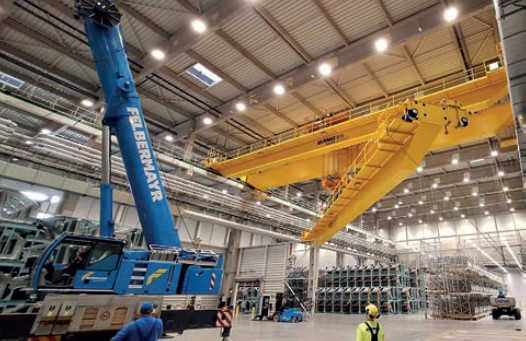We believe that the study of some cases will improve our experience, and today we analyze several cases of crane application in the automotive industry.
We will provide a comprehensive analysis of the application of cranes in the automotive industry based on the given information. The automotive industry is a highly complex and diverse field that requires precise handling of various components. Cranes play a crucial role in handling and lifting these components, ensuring their safe transportation and installation.
Another factor to consider is the efficiency of the crane system. The automotive industry requires high production rates and low downtime. Therefore, it is essential to choose a crane system that is reliable, efficient, and easy to maintain. The selection of appropriate lifting equipment, such as hooks, slings, and spreader bars, is also crucial for efficient handling of components.
In conclusion, the application of cranes in the automotive industry is essential for handling and lifting components efficiently and safely. It is crucial to select the appropriate type of crane based on the specific requirements of the application and to ensure that operators are trained and authorized to operate the cranes safely. Additionally, it is essential to maintain the crane system efficiently to ensure high production rates and low downtime in the automotive industry.
The first case was a handling system for a British sports car manufacturer. The crane company provides handling solutions for lifting and maneuvering chassis frames, component frames, fuel tanks, batteries, instrument panels, wiring harness and fuse box assemblies, seat frames, seats, wheels, tailgates and doors in a weight range of 15 kg to 600 kg.
The company designs a range of innovative solutions to meet customer needs. These include pneumatic counterbalance arm handling, which the company says “proves to be the ideal solution for the required reach requirements,” where “reach” means the load being lifted needs to reach the interior of the vehicle – for example, installing a car seat that will The chair is placed into the vehicle; the electronic balancer handles “accurate and rapid movement with touch-sensitive control and automatic balancing of the load”; and the electronic linear handling enables balanced linear movement of the load.
Additional column jibs, electric chain hoists, conveyors, fixtures and a lightweight XY mobile gantry crane were also supplied to complete the project.

The second case is installed an outdoor, manual freestanding monorail and a hoist for a US national commercial truck dealer.
A national commercial truck dealer in the transportation industry sought the expertise of a crane supplier to design, build and install an outdoor manual freestanding monorail, complete with an 8.0 ton capacity crane, crane guard and Detroit-resistant epoxy paint, Michigan winter.
The permanently installed monorail crane system features 15 feet of width clearance and 14 feet of height clearance designed to facilitate tractor unloading from the semi-truck.
The automotive industry uses various types of cranes, including overhead cranes, gantry cranes, and jib cranes. These cranes are designed to handle different types of loads, such as sheet metal, engine components, and chassis parts. The selection of the appropriate crane depends on the specific requirements of the application, including the weight and size of the load, the space available, and the lifting height required.
One important consideration in the application of cranes in the automotive industry is safety. Cranes are heavy machines that can cause serious damage and injury if not operated properly. Therefore, it is essential to ensure that operators are trained and authorized to operate the cranes safely. Additionally, it is crucial to follow all safety procedures and guidelines to prevent accidents and ensure a safe working environment.

The third case is an automotive recycler that sells parts to automotive original equipment manufacturers and their dealers, commercial and municipal fleets, and extended warranty coverage and insurance companies.
The auto recycler’s original idea was to purchase a ceiling-mounted top-running 5.0-ton bridge crane, but upon inspection by the crane manufacturer, it was discovered that the then-new building would require additional steel structure to support the weight generated by Cranes and the loads they carry. Unfortunately, the building had to be redesigned and rebuilt, but due to expense and loss of production time, this was not an option.
A solution involving a single crane was chosen, and due to the complexity of the application and the unsuitability of a standard crane, they ultimately opted to create a bespoke design.
The unique workstation bridge crane system consists of several side-by-side systems, one end being floor-supported using hangman columns, with intermediate supports ceiling-mounted on additional steelwork designed to support adjacent cranes from a single beam above.
Each crane system provides a lifting capacity of 1.0 ton to each of the five areas requiring handling/lifting assistance, and being majority ceiling-mounted this meant the floor space could remain unrestricted.

Contact our crane specialists
Send us a message and we will get back to you as soon as possible.